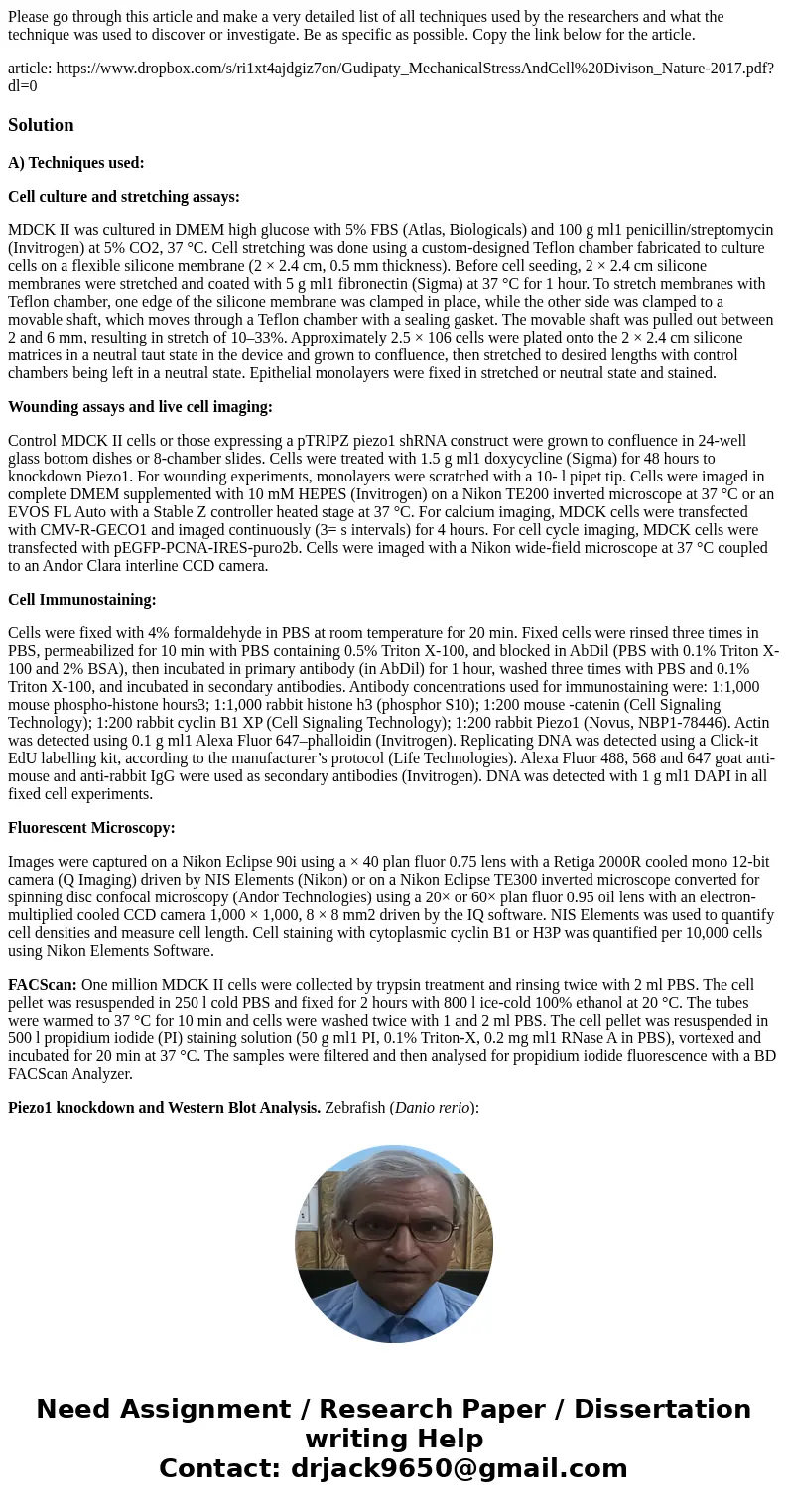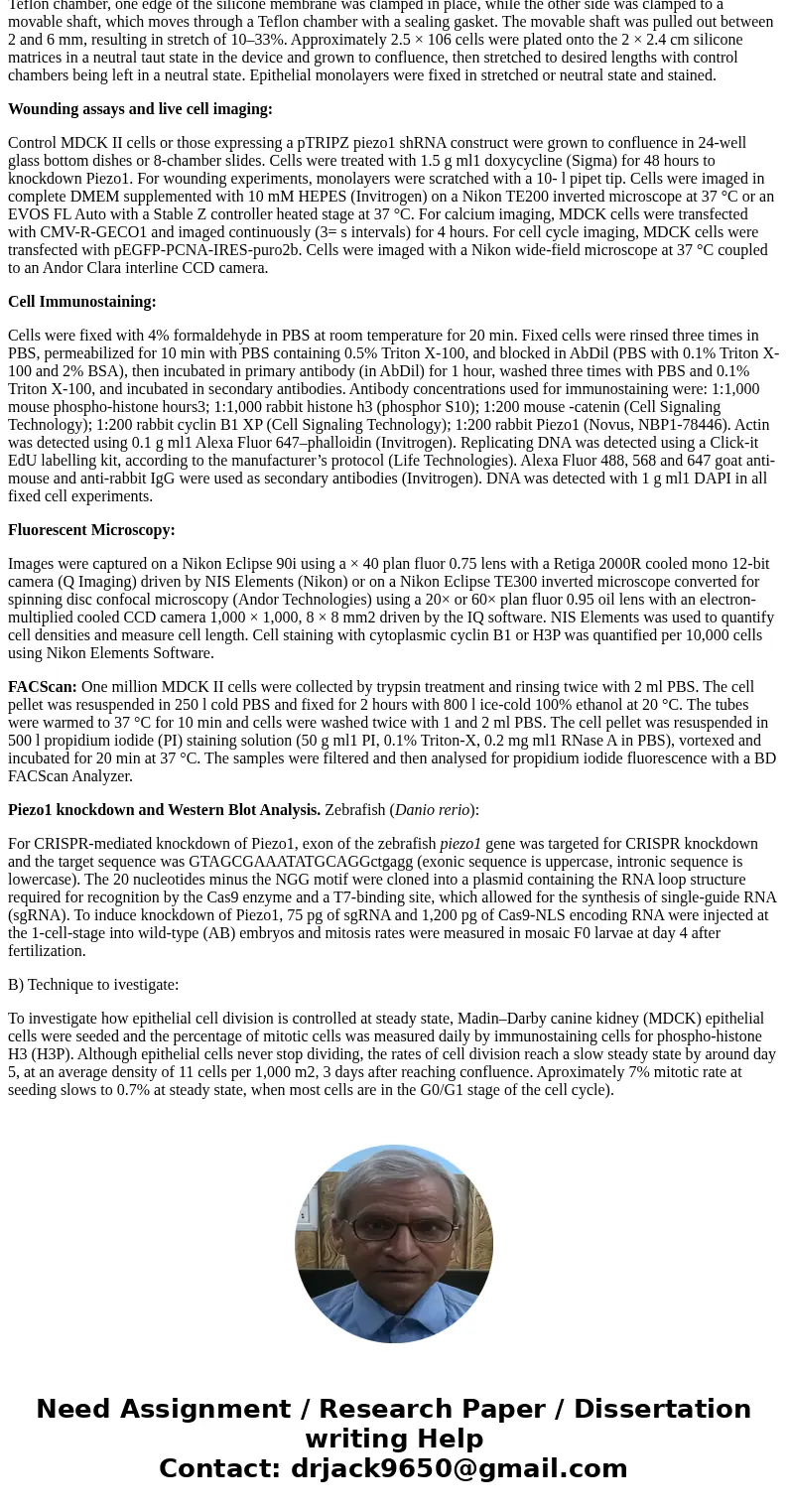Please go through this article and make a very detailed list
Please go through this article and make a very detailed list of all techniques used by the researchers and what the technique was used to discover or investigate. Be as specific as possible. Copy the link below for the article.
article: https://www.dropbox.com/s/ri1xt4ajdgiz7on/Gudipaty_MechanicalStressAndCell%20Divison_Nature-2017.pdf?dl=0
Solution
A) Techniques used:
Cell culture and stretching assays:
MDCK II was cultured in DMEM high glucose with 5% FBS (Atlas, Biologicals) and 100 g ml1 penicillin/streptomycin (Invitrogen) at 5% CO2, 37 °C. Cell stretching was done using a custom-designed Teflon chamber fabricated to culture cells on a flexible silicone membrane (2 × 2.4 cm, 0.5 mm thickness). Before cell seeding, 2 × 2.4 cm silicone membranes were stretched and coated with 5 g ml1 fibronectin (Sigma) at 37 °C for 1 hour. To stretch membranes with Teflon chamber, one edge of the silicone membrane was clamped in place, while the other side was clamped to a movable shaft, which moves through a Teflon chamber with a sealing gasket. The movable shaft was pulled out between 2 and 6 mm, resulting in stretch of 10–33%. Approximately 2.5 × 106 cells were plated onto the 2 × 2.4 cm silicone matrices in a neutral taut state in the device and grown to confluence, then stretched to desired lengths with control chambers being left in a neutral state. Epithelial monolayers were fixed in stretched or neutral state and stained.
Wounding assays and live cell imaging:
Control MDCK II cells or those expressing a pTRIPZ piezo1 shRNA construct were grown to confluence in 24-well glass bottom dishes or 8-chamber slides. Cells were treated with 1.5 g ml1 doxycycline (Sigma) for 48 hours to knockdown Piezo1. For wounding experiments, monolayers were scratched with a 10- l pipet tip. Cells were imaged in complete DMEM supplemented with 10 mM HEPES (Invitrogen) on a Nikon TE200 inverted microscope at 37 °C or an EVOS FL Auto with a Stable Z controller heated stage at 37 °C. For calcium imaging, MDCK cells were transfected with CMV-R-GECO1 and imaged continuously (3= s intervals) for 4 hours. For cell cycle imaging, MDCK cells were transfected with pEGFP-PCNA-IRES-puro2b. Cells were imaged with a Nikon wide-field microscope at 37 °C coupled to an Andor Clara interline CCD camera.
Cell Immunostaining:
Cells were fixed with 4% formaldehyde in PBS at room temperature for 20 min. Fixed cells were rinsed three times in PBS, permeabilized for 10 min with PBS containing 0.5% Triton X-100, and blocked in AbDil (PBS with 0.1% Triton X-100 and 2% BSA), then incubated in primary antibody (in AbDil) for 1 hour, washed three times with PBS and 0.1% Triton X-100, and incubated in secondary antibodies. Antibody concentrations used for immunostaining were: 1:1,000 mouse phospho-histone hours3; 1:1,000 rabbit histone h3 (phosphor S10); 1:200 mouse -catenin (Cell Signaling Technology); 1:200 rabbit cyclin B1 XP (Cell Signaling Technology); 1:200 rabbit Piezo1 (Novus, NBP1-78446). Actin was detected using 0.1 g ml1 Alexa Fluor 647–phalloidin (Invitrogen). Replicating DNA was detected using a Click-it EdU labelling kit, according to the manufacturer’s protocol (Life Technologies). Alexa Fluor 488, 568 and 647 goat anti-mouse and anti-rabbit IgG were used as secondary antibodies (Invitrogen). DNA was detected with 1 g ml1 DAPI in all fixed cell experiments.
Fluorescent Microscopy:
Images were captured on a Nikon Eclipse 90i using a × 40 plan fluor 0.75 lens with a Retiga 2000R cooled mono 12-bit camera (Q Imaging) driven by NIS Elements (Nikon) or on a Nikon Eclipse TE300 inverted microscope converted for spinning disc confocal microscopy (Andor Technologies) using a 20× or 60× plan fluor 0.95 oil lens with an electron-multiplied cooled CCD camera 1,000 × 1,000, 8 × 8 mm2 driven by the IQ software. NIS Elements was used to quantify cell densities and measure cell length. Cell staining with cytoplasmic cyclin B1 or H3P was quantified per 10,000 cells using Nikon Elements Software.
FACScan: One million MDCK II cells were collected by trypsin treatment and rinsing twice with 2 ml PBS. The cell pellet was resuspended in 250 l cold PBS and fixed for 2 hours with 800 l ice-cold 100% ethanol at 20 °C. The tubes were warmed to 37 °C for 10 min and cells were washed twice with 1 and 2 ml PBS. The cell pellet was resuspended in 500 l propidium iodide (PI) staining solution (50 g ml1 PI, 0.1% Triton-X, 0.2 mg ml1 RNase A in PBS), vortexed and incubated for 20 min at 37 °C. The samples were filtered and then analysed for propidium iodide fluorescence with a BD FACScan Analyzer.
Piezo1 knockdown and Western Blot Analysis. Zebrafish (Danio rerio):
For CRISPR-mediated knockdown of Piezo1, exon of the zebrafish piezo1 gene was targeted for CRISPR knockdown and the target sequence was GTAGCGAAATATGCAGGctgagg (exonic sequence is uppercase, intronic sequence is lowercase). The 20 nucleotides minus the NGG motif were cloned into a plasmid containing the RNA loop structure required for recognition by the Cas9 enzyme and a T7-binding site, which allowed for the synthesis of single-guide RNA (sgRNA). To induce knockdown of Piezo1, 75 pg of sgRNA and 1,200 pg of Cas9-NLS encoding RNA were injected at the 1-cell-stage into wild-type (AB) embryos and mitosis rates were measured in mosaic F0 larvae at day 4 after fertilization.
B) Technique to ivestigate:
To investigate how epithelial cell division is controlled at steady state, Madin–Darby canine kidney (MDCK) epithelial cells were seeded and the percentage of mitotic cells was measured daily by immunostaining cells for phospho-histone H3 (H3P). Although epithelial cells never stop dividing, the rates of cell division reach a slow steady state by around day 5, at an average density of 11 cells per 1,000 m2, 3 days after reaching confluence. Aproximately 7% mitotic rate at seeding slows to 0.7% at steady state, when most cells are in the G0/G1 stage of the cell cycle).


 Homework Sourse
Homework Sourse